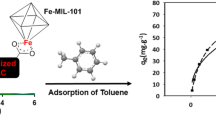Abstract
A sequential design of experiments was used to optimize the MOF-801 synthesis process for toluene adsorption. First, mixture design was employed on optimizing precursor concentration. Three chemical materials, fumaric acid, N,N-dimethylformamide and formic acid, were selected to optimize their composition using extreme vertices design methods. By analysis of variance (ANOVA), the model was expected to be acceptable for statistical prediction. The optimal precursor composition for the synthesis of MOF-801 was predicted on a molar basis as fallows: ZrOCl2·8H2O: fumaric acid: dimethylformamide: formic acid=1.0: 1.7: 43.3: 39.5. Thereafter, 23 factorial design was selected to investigate the effect of synthesis reaction conditions such as temperature, time and stirring speed. By the statistical analysis of eight adsorption runs, stirring speed could be excluded in further investigation. Central composite design with synthesis time and temperature was performed to optimize the synthesis process. The results were estimated using the quadratic model equation derived through nine synthesis experiments. Using this model, it was predicted that MOF-801 prepared under the synthesis time and temperature of 158 °C and 12 h, respectively, had the maximum amount of toluene adsorption. Indeed, after synthesizing MOF-801 with the optimized synthesis conditions, an actual adsorption capacity of the samples was 151.9 mg/g, close to the predicted value of 95.5%.
Similar content being viewed by others
References
W. Wu, B. Zhao, S. Wang and J. Hao, J. Environ. Sci, 53, 224 (2017).
Y. Lu, J. Liu, B. Lu, A. Jiang and C. Wan, J. Hazard. Mater., 182, 204 (2010).
L. Ma, M. He, P. Fu, X. Jiang, W. Lv, Y. Huang, Y. Liu and H. Wang, Sep. Purif. Technol., 235, 116146 (2020).
X. Li, L. Zhang, Z. Yang, P. Wang, Y. Yan and J. Ran, Sep. Purif. Technol., 235, 116213 (2020).
P. F. Biard, A. Couvert and S. Giraudet, J. Ind. Eng. Chem., 59, 70 (2018).
W. Wu, B. Zhao, S. Wang and J. Hao, J. Environ. Sci., 53, 224 (2017).
K. Vellingiri, P. Kumar, A. Deep and K. H. Kim, Chem. Eng. J., 307, 1116 (2017).
T. K. Vo, V. N. Le, K. S. Yoo, M. Song, D. Kim and J. Kim, Cryst. Growth Des., 19, 4949 (2019).
H. Liu, Y. Yu, Q. Shao and C. Long, Sep. Purif. Technol., 228, 115755 (2019).
P. Yang, M. Song, D. Kim, S. P. Jung and Y. Hwang, Korean J. Chem. Eng., 36, 1806 (2019).
M. A. Lillo-Ródenas, D. Cazorla-Amorós and A. Linares-Solano, Carbon, 43, 1758 (2005).
G. Mirth and J. A. Lercher, J. Phys. Chem., 95, 3736 (1991).
S. Kubo and K. Kosuge, Langmuir, 23, 11761 (2007).
S. Van der Perre, T. Van Assche, B. Bozbiyik, J. Lannoeye, D. E. De Vos, G. V. Baron and J. F. M. Denayer, Langmuir, 30, 8416 (2014).
C. Y. Huang, M. Song, Z. Y. Gu, H. F. Wang and X. P. Yan, Environ. Sci. Technol., 45, 4490 (2011).
T. K. Vo, J. H. Kim, H. T. Kwon and J. Kim, J. Ind. Eng. Chem., 80, 345 (2019).
F. D. Lahoz-Martín, A. Martín-Calvo and S. Calero, J. Phys. Chem. C, 118, 13126 (2014).
D. W. Lee, T. Didriksen, U. Olsbye, R. Blom and C. A. Grande, Sep. Purif. Technol., 235, 116182 (2020).
D. J. Tranchemontagne, J. L. Mendoza-Cortes, M. O’Keeffe and O. M. Yaghi, Chem. Soc. Rev., 38, 1257 (2009).
Y. Bai, Y. Dou, L.H. **e, W. Rutledge, J.R. Li and H.C. Zhou, Chem. Soc. Rev., 45, 2327 (2016).
G. Wißmann, A. Schaate, S. Lilienthal, I. Bremer, A. M. Schneider and P. Behrens, Micropor. Mesopor. Mater., 152, 64 (2012).
G. Zahn, H. A. Schulze, J. Lippke, S. König, U. Sazama, M. Fröba and P. Behrens, Mieropor. Mesopor. Mater., 203, 186 (2015).
H. Furukawa, F. Gandara, Y. B. Zhang, J. Jiang, W. L. Queen, M. R. Hudson and O. M. Yaghi, J. Am. Chem. Soc., 136, 4369 (2014).
Acknowledgements
This study was supported by the Research Program funded by the SeoulTech(Seoul National University of Science and Technology).
Author information
Authors and Affiliations
Corresponding author
Rights and permissions
About this article
Cite this article
Lee, S., Lee, M.H., Yoo, K.S. et al. Assessment of MOF-801 synthesis for toluene adsorption by using design of experiment methodology. Korean J. Chem. Eng. 39, 3129–3137 (2022). https://doi.org/10.1007/s11814-022-1199-8
Received:
Revised:
Accepted:
Published:
Issue Date:
DOI: https://doi.org/10.1007/s11814-022-1199-8




